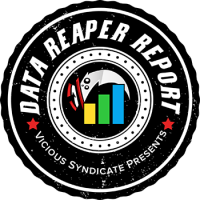
Welcome to the 265th edition of the Data Reaper Report! This is the first report following the release of the Audiopocalypse mini-set.
Contributing to the Data Reaper project through Hearthstone Deck Tracker or Firestone allows us to perform our analyses and to issue the weekly reports, so we want to wholeheartedly thank our contributors. Without the community’s contributions, there would be no project. Contributing data is very easy, so if you enjoy our content and would like to make sure it remains consistent and free – Sign up!
Quick Links
Class/Archetype Distribution | Class Frequency | Matchup Winrates | vS Power Rankings | vS Meta Score | Class Analysis & Decklists | Meta Breaker of the Week | How to Contribute | Credits
Number of Games
| Overall | 800,000 |
| Top 1K Legend | 27,000 |
| Legend (Excluding Top 1k) | 7,000 |
| Diamond 4 to 1 | 85,000 |
| Diamond 10 to 5 | 135,000 |
| Platinum | 136,000 |
| Bronze/Silver/Gold | 410,000 |
Class/Archetype Distribution
[TABS_PRO id=62881]
Class Frequency
[TABS_PRO id=62882]
Class Frequency Discussion
The three established Demon Hunter archetypes (Relic, Big, Outcast) haven’t seen much change in their card choices. Relic DH remains the most popular of the three, as Big and Outcast have been contained to small numbers. Spell DH, previously deleted by the nerf to Sinful Brand, is roaring to come back to the format, establishing a visible presence at legend.
Death Knight’s popularity is a given. Blood-Ctrl DK continues to be one of the most popular decks in the format, with some of its builds utilizing the newly-introduced Hollow Hound. There is a lot of experimentation in both Frost-Aggro and Unholy-Aggro DK that’s centered on a deathrattle package with Yelling Yodeler. Blight Boar Death Knights, running a Bonelord OTK with Cage Head, haven’t gained traction.
Pure Paladin is entering unfamiliar territory, becoming increasingly more popular at higher MMR brackets. The deck is currently spiking at all levels of play, on pace to eclipse a 20% play rate at Diamond 4 and above. Yes, even at top legend, Pure Paladin seems to be taking over the format. This phenomenon has been ignited by recent builds utilizing Horn of the Windlord and an off-board burst damage package.
Excitement seems to surround Enrage Warrior with the addition of Jam Session. Menagerie Warrior has also received big upgrades to its build, with both Backstage Bouncer and Abyssal Bassist making strong cases for their inclusion. The deck’s play rate is finally quite visible. Control Warrior, on the other hand, is not generating much noise.
Control Priest seems to attract most of the attention within its class, with Undead Priest taking a noticeable step back in play since the launch of the mini-set. Both of these archetypes are not utilizing new cards.
Hunter has been transformed by the addition of Hollow Hound and Star Power. A new build has taken over the class, pushing older iterations of Naga and Big-Beast Hunter to the sidelines. It is centered on buffing and copying Hollow Hound, so we found it most appropriate to call it Hound Hunter. Hound Hunter has a small fraction of Renathal builds.
Mage is relatively unchanged, focused on either Spooky-Ctrl or Spooky-Burn. Some Spooky-Ctrl builds have begun running Renathal and Star Power. Star Power is mostly absent from 30-card builds.
Chad Warlock has been trying out Reverberation and Fanottem. Imp Warlock has seen no noticeable changes. Players are trying out Curse Warlock for the 145th time.
Rogue is passing on another set of cards, with interest in the class reaching a fairly low point. It’s Miracle Rogue or nothing.
Druid is a complete mess. Big Druid is the only fleshed-out archetype here.
Totem Shaman is around, even experimenting with several new cards, but few players care to try it.
[TABS_PRO id=62884]

[TABS_PRO id=62885]
vS Meta Score
[TABS_PRO id=62886]
vS Power Rankings Discussion
The current meta lives up to its name. It is truly apocalyptic. Let’s start with the obvious cause:
Paladin
- Pure Paladin’s play rate at top legend should have been the dead giveaway to anyone paying attention. If top legend players start piloting Pure Paladin en masse, it has to mean the deck is incredibly broken.
- Pure Paladin initially looked like one of several strong frontrunners in the first couple of days of the mini-set, as it usually tends to be. We weren’t too worried about it then. However, once a new build emerged that utilizes Horn of the Windlord alongside all the attack buffs available to the class, imitating a Doomhammer/Rockbiter package, it was game over for the rest of the format. The win rate was elevated to another level, the matchup spread became near perfect, and high-level players could no longer consistently outplay it, as they have successfully done in the past.
- The key to breaking Pure Paladin and turning it into a near-unstoppable strategy, was giving it insane off-board burst damage. Pure Paladin used to be a deck that could no longer kill you if you managed to clear its threats. You could focus on outpacing it in the early game, or pick apart its board development to survive to your late game, knowing you were safe. This is no longer the case, as Horn of the Windlord means that even if the Paladin has no minions in play, you can still die to their off-board reach. This makes it increasingly difficult to establish effective counterplay.
- We can notice the dramatic impact this change has had on Pure Paladin’s matchups at higher levels of play. Pure Paladin used to decline in its performance in matchups at top legend by 4-8%, putting it at the very bottom of our internal ‘skill ceiling’ metric. Current Pure Paladin sits at an average skill trajectory, meaning it does not lose significant percentages in matchups at higher levels of play.
- What’s crazy is that Pure Paladin has not reached its final form. The archetype is relatively unrefined, especially at lower ranks of ladder where most players are not aware of its strongest build. This means the scope for further improvement in its performance is high.
- The deck does have some unfavored matchups that are worth noting. Spell DH is its most popular and effective counter. Outcast DH does well in the matchup too. Mage and Miracle Rogue show the potential to challenge it, though it’s no guarantee that they can genuinely counter it. Beyond that, good luck.
Demon Hunter
- Spell DH has returned to competitive relevance, though its behavior is different from the past. It’s become much more focused on its S’theno OTK potential thanks to the addition of Through Fel and Flames and the loss of Sinful Brand. It makes the deck much more complicated to pilot, meaning it is much better at top legend, where it has managed to hit Tier 1, compared to the rest of ladder where it mostly sits at Tier 3. This is why we only expect it to become a prominent deck at higher levels of play, even though it is the strongest counter to Pure Paladin.
- Relic DH seems to do okay. Players love running attrition decks such as Blood-Ctrl DK and Control Priest, which gives Relic DH a favorable field. But, the deck does struggle against Spell DH and Enrage Warrior, while the Paladin matchup isn’t easy either. It doesn’t seem to match up well enough against the best performers in the format.
- Big DH faces a very similar problem. It cannot crack the Pure Paladin/Enrage Warrior/Spell DH trio, so while it’s a decent enough deck, it hits a wall once it constantly runs into the best performers.
- Outcast DH may have a good matchup into Pure Paladin, but it has other serious problems in the format. It greatly struggles against Death Knights and other Demon Hunter decks. Since those classes remain very popular, the field seems quite hostile to it. Considering how difficult it is to play too, we can’t expect it to rise in play and provide a real answer to Pure Paladin, even if it gets better due to the spike in the meta tyrant’s popularity.
Death Knight
- A familiar pattern is emerging with Blood-Ctrl DK. It looks like a good deck at lower ranks, but one that gets exposed at higher levels of play, where it has a lot of bad matchups. Its win rate at top legend should get carried by its Spell DH matchup, keeping it viable. Otherwise, it’d be sinking to Tier 4.
- After the dramatic change in Pure Paladin, Frost-Aggro DK is now the deck that falls off the hardest at higher levels of play. It gets exposed by a variety of matchups, including a Pure Paladin matchup that has completely flipped on its head. The Paladin is favored now thanks to the racing potential of Horn of the Windlord and the healing provided by Feast and Famine.
- The stats for Unholy-Aggro DK are not reflective of its true power. This is the least refined deck in the Power Ranking table, as many players have been baited and bamboozled by fraudulent Deathrattle/Yodeler builds. In its optimal form, Unholy-Aggro DK is very comfortably a Tier 2 deck (at least) at all levels of play. We think it’s likely to become the best Death Knight deck post-refinement.
Warrior
- Enrage Warrior is the 2nd best deck in the format, only eclipsed by the monstrous Pure Paladin. Jam Session is one of the best cards in the deck, so it’s had a big impact on its stellar performance. It’s a deck to watch out for in the event of Paladin nerfs, though it does have other counters.
- Menagerie Warrior is another deck that’s very unrefined and hasn’t found its optimal form, so we strongly suspect its scope for potential improvement is one of the highest in the field. We estimate a Tier 2 placement for its optimal form above Diamond 4, and a Tier 1 placement below Diamond 4. This is a very promising deck once it figures out how to best utilize its strong additions.
- The new cards have been a bit awkward to use in Control Warrior, for reasons we’ll specify later, so it hasn’t enjoyed a big boost in power. It’s not the worst deck in the game, but it’s not very good either.
Priest
- Not too different from Blood-Ctrl DK, Control Priest is a popular, yet vulnerable deck. What’s most dramatic about its performance in the current meta is how bad the Pure Paladin matchup has become once Horn of the Windlord took over. The off-board burst damage specifically targets a removal-based strategy such as Control Priest, which also doesn’t have too much life gain to combat it. Add the oppressive Relic DH matchup, as well as a tricky Spell DH matchup, and you have a Tier 3 performer across all ranks.
- Undead Priest is in collapse. From a Tier 1 performer, it has fallen to Tier 3. Getting no new cards, while the rest of the field has improved, can do that to a deck. The rise in life gain options, even in faster decks you wouldn’t normally expect it from (Feast and Famine/Hollow Hound/One-Amalgam Band), has added further difficulties.
Hunter
- Hound Hunter looks very promising. At one point, it was on a trajectory to become the best deck in the game, but the dramatic developments in Pure Paladin have blocked that path. Hollow Hound and Star Power have given the class another dimension to its game, making Hunter much more versatile and capable of consistently mounting comebacks. Its matchup spread paints a very clear picture. Pure Paladin and Enrage Warrior, the two best decks in the game, present the biggest roadblocks to Hound Hunter’s growing success. Take those away and Hound Hunter would have a clear path to the #1 spot.
Mage
- Both Mage decks exhibit the potential of countering Pure Paladin to some degree, but they have other issues that prevented them from becoming more prevalent. Spooky Mage’s matchup spread is terribly polarizing. Some opponents (Relic DH, Hound Hunter, and Enrage Warrior) farm it almost for free, while Death Knights of all kinds give it problems. A deck that loses so hard to popular meta decks cannot consistently see success. Burn Mage faces similar problems with the same classes, though it does much better into Relic DH. We do think that Mage players might be sleeping on one of the best cards in the mini-set, not utilizing it as much as they should.
Warlock
- Most classes in the format suffer under the oppressive rule of Pure Paladin, but no class suffers more than Warlock. Chad Warlock already had a terrible matchup against Pure Paladin, so it definitely didn’t want that deck to get better. Imp Warlock has a better chance against Paladin, but does not appreciate the rise of Hound Hunter. Warlock is one of the two worst classes in the game.
Rogue
- You’d think that Rogue was unplayable based on its play rate. It’s definitely having problems finding relevance at lower ranks of ladder, but Miracle Rogue is finding a surprising amount of success at top legend. It’s a bit underrated, since it is one of the only decks in the format that does not fear the Pure Paladin matchup while boasting a strong matchup into Enrage Warrior. We think its play rate is low because it loses to arguably two of the most hated decks in the format: Spell DH and Control Priest. The tilt factor certainly could be at play here.
Druid
- Druid decks are generally very messy and carry a low play rate, so we didn’t feel comfortable placing them in the Power Rankings. We can tell you that Big Druid looks tolerable, though the Pure Paladin matchup likely scares everyone away. Any other Druid iteration looks like complete garbage. The class needs help.
Shaman
- Totem Shaman isn’t doing badly on the surface, but we’re noticing a steep decline in the deck’s performance over time, so it should sink to Tier 3 at multiple rank brackets by next week. Either way, faster decks that aren’t Pure Paladin are going to be hard to justify playing, especially when it comes to a Shaman deck that players were already uninterested in trying out. There’s a new Totem Shaman build that’s interesting enough to talk about for future reference, but it shouldn’t change the archetype’s prospects in this specific format.
Class Analysis & Decklists
Death Knight | Demon Hunter | Druid | Hunter | Mage | Paladin | Priest | Rogue | Shaman | Warlock | Warrior
Feno has advocated for running Enchanters in Relic Demon Hunter for a while, but the card never got enough traction until now. We like how Enchanter performs in the current meta. Not only is it a strong amplifier of the Unleash Fel combo, but it is also very strong with Relic of Extinction, which can be crucial when dealing with some of Pure Paladin’s most intimidating boards. Otherwise, the Demon Hunter stands little chance of clearing their biggest threats.
Spell Demon Hunter has made yet another comeback behind the addition of Through Fel and Flames. The deck is much more reliant on a S’theno OTK to kill the opponent since you no longer have Sinful Brand as a damage source. This makes the deck more difficult to pilot as your resource management needs to be on point. This has had an impact on the performance of Feast of Souls. The card used to look very weak. We’ve previously advocated cutting it, which improved the deck, but it performs much better now. Running one copy of it is a sensible decision.
Big Demon Hunter hasn’t changed. Most players are running the Enforcer build. Outcast Demon Hunter is experimenting with Through Fel and Flames, but this deck already doesn’t like S’theno very much. Going harder into a S’theno combo doesn’t make much sense here.
- Demon Hunter Class Radar
- Relic Demon Hunter
- Spell Demon Hunter
- Big Demon Hunter
- Outcast Demon Hunter
Hollow Hound is a decent card in Blood-Ctrl Death Knight. It is not a star performer, but what sold us on it is the possibility of running Lor’themar Theron. Theron has been a popular member of ETC bands in Blood-Ctrl, which we’ve never been impressed with, but we noticed a significant improvement in this build path once Hollow Hound was added.
Since the deck ends up needing to cut Tour Guide to make way for this package, Hipster has looked like a strong replacement for Amalgam of the Deep. Hipster is always active on turn 2. Note that Dirty Rat is terrible in the current meta, so it’s missing on purpose.
For the first time, Hardcore Cultist looks like a card you should be running in Frost-Aggro Death Knight. It’s huge in the Paladin matchup, replacing Rowdy Fan.
For the moment, all experimentations involving deathrattle packages and Yelling Yodeler in Unholy-Aggro Death Knight look like rabbit holes. These builds greatly underperform compared to pre-Audiopocalypse builds.
However, we can make a couple of changes to the old build and improve it. We’ve evaluated Magatha in multiple archetypes and concluded that the card is nuts if you run almost no spells in the deck. The presence of Magatha makes all spells in a deck much worse, so only a strategy-defining card such as Grave Strength is worth running. Cutting Plague Strike for Bone Flinger is worth the upgrade from Famished Fool to Magatha. The extra slot goes to Blightfang, which goes back to the deck because it’s a very powerful card in the Paladin matchup.
Pure Paladin is broken. The deck looked quite good in the early days of the mini-set, but didn’t scare us until a build from Noodleswoop emerged, leveraging Horn of the Windlord to the max. By running both ‘Feast and Famine’ and ‘For Quel’Thalas!’, it becomes extremely difficult for the opponent to avoid the Paladin’s off-board reach.
This off-board burst added on top of a deck that already excelled at exerting board pressure has been too much for the format to handle. The Purator package is geared to flip the board state even if the Paladin has fallen behind, thanks to Lightray, Anachronos, and The Leviathan. You don’t need to concern yourself with board-centric cards such as Funkfin and Jitterbug. Your board pressure is almost a distraction for the eventual Horn finish. Even players at top legend have conceded defeat. You cannot consistently outplay this build, as it has no significant weaknesses to exploit.
Kotori is the worst card in the build. We wonder if Order in the Court can replace it. We don’t have much data on Order being played in Horn lists and understand why it could be awkward due to the importance of finding Feast and Famine/For Quel’Thalas in the late game. It’s something worth trying.
Enrage Warrior is the 2nd best deck in the game. The addition of Jam Session has been a big boost to the deck. We’ve made a few changes to the deck compared to its pre-Audiopocalypse iteration.
Both Treasure Guard and Frightened Flunky look strong. Taunts generally perform well in Enrage Warrior since they’re great minions to draw with Chorus Riff and buff with Imbued Axe. They also scale well in the late game since they give you additional resources and help you fill the curve. Having some cheap taunts going into turns 7-8 against Paladin can be a lifesaver if they’ve equipped Horn of the Windlord.
The cards to make way are Roaring Applause, Acolyte of Pain, and Instrument Tech; decent sources of card draw but less synergistic compared to Flunky/Guard. Wild Pyromancer becomes redundant since Jam Session is so much better as a self-damage enabler.
Menagerie Warrior also got some exciting cards but has proven to be more complicated to build. Based on our studies of popular builds propagated by Feno and ZachO, we’ve reached a few conclusions that led us to the featured build:
- Backstage Bouncer is nuts and needs to have ‘enough’ 1-drops to enable it (6-7).
- Abyssal Bassist is nuts and consequently, so is Remixed Tuning Fork.
- Magatha is amazing since Roaring Applause is the only spell you run.
- Hawkstrider Rancher is only a good card if you run a lot of 1-drops (~10) but running too many 1-drops hurts your late game.
- You want to maximize your tribe count above all else, even if it means dropping generically useful cards such as Astalor.
Maximizing the tribe count means splitting Stereo Totem and Rolling Stone as 1-copy of each. Razorfen Rockstar is a weaker 1-drop than Murmy because of Backstage Bouncer, so it is also a single copy, just to have a Quillboar in the deck. Your best Amalgam of the Deep target in this deck is Abyssal Bassist, since it’s guaranteed to give you a One-Amalgam Band.
Zola is the wild card addition that can significantly improve the matchup against Blood-Ctrl DK and other decks that try to run you out of resources, since you can combo it with Voone in the late game and have ‘infinite’ hand value. It can copy a Power Slider, Abyssal Bassist, Nellie, or just a One-Amalgam Band too. Remember that it’s a Naga, so it also just adds to the tribe count.
Control Warrior ended up accepting Abyssal Bassist and Remixed Tuning Fork, but it’s a bit of an awkward exchange as Sword Eater has consistently been a trap card for the deck due to Last Stand.
Control Priest is in a tough spot because the matchup against Pure Paladin is clearly unfavored, following the addition of their Doomhammer package. The only way out of this spot is to run two Vipers, which is extremely valuable since it targets both Horn of the Windlord and Disco Maul. Dirty Rat is terrible in the current meta and particularly bad against Paladins, so we strongly dislike it. The rest of the build is almost identical to the one from Xilinhung. You need early game minions against Paladin to be able to contest their early development and not fall behind before they equip Horn and/or play Countess. Shadow Word: Ruin helps you against Countess and Lightray turns. Steamcleaner is in the ETC band to help against Demon Hunters (Fizzle/Spell DH).
Hollow Hound is a transformational card in the Hunter class, leading to the emergence of Hound Hunter. The class’ strongest build, pioneered by Piki, looks to maximize the potential of this beast.
This deck has the normal early game of Bananas and Monkeys but prioritizes Thornmantle Musician because it can be a strong setup card for Hollow Hound later in the game. For the same reason, Hope of Quel’Thalas is extremely important and is one of the very best cards in the deck.
Another promising addition is Star Power. The spell is so strong alongside Hollow Hound that Hunter now has massive comeback potential. It’s worth investing in a small Arcane package with Halduron Brightwing and Conjured Arrow to maximize Star Power.
One change we’ve made to the deck is to add Lor’themar Theron over a 2nd Faithful Companion. Based on our evaluation of Theron in Renathal builds of Hound Hunter as well as Blood-Ctrl Death Knight (which also runs Hollow Hound), it is likely a very strong card in the deck. Two copies of Faithful Companions are a bit of an overkill.
Note that Renathal builds of Hound Hunter are much, much worse than the featured build. It’s not even close.
Star Power is mostly utilized in Hunter, but we think it’s being greatly underestimated in Mage. Burn Mage has not even experimented with the card, but it could be huge in allowing us to answer big boards that the Mage normally struggles with, while synergizing with Cosmic Keyboard. The cuts might be cards that players are attached to, but Infinitize the Maxitude and Commander Sivara are fringe performers.
Star Power mostly sees play in Renathal builds of Spooky Mage, where it is a very strong performer. However, Renathal builds of Spooky Mage look much worse. They don’t compare to 30-card builds, even though 30-card builds usually don’t run Star Power. We recommend cutting Arcane Wyrm to make way for Star Power.
Chad Warlock has been experimenting with new cards. Reverberation looks quite strong both offensively and defensively, so we like its inclusion alongside Mortal Coil. Tour Guide and Siphon Soul are cut to make room for them.
Fanottem is a bit more awkward to run in the primary build of the deck. You want to run Jailer with it, but you also want to make sure that Movement of Pride can tutor Jailer or Thaddius. This is why we strongly suspect that Fanottem is better off being part of the ETC band. Against decks that can clear immune minions, you pick Rivendare. Against decks that don’t have the ability to answer a Jailer board, you pick Fanottem. We opted to drop one Habeas Corpses to make room for Jailer in the primary list.
There are no notable changes in Rogue. Miracle Rogue wants to run Fan of Knives because of the Paladin matchup. Neophyte is mostly impactful against Demon Hunter but tends to be worse than Fan of Knives in many other matchups.
Other Rogue decks look subpar.
Big Druid is the only competitive avenue for the class, and it hasn’t been impacted by the mini-set. The same build looks like the best approach. Some players have tried out a ‘Chad package’, with Jailer, Thaddius, and Flesh Behemoth, but it looks inferior.
Backstage Bouncer and Remixed Totemcarver look like good cards in Totem Shaman, especially Bouncer. You can cut Flametongue Totem and Ancestral Knowledge for them. Running too much draw can punish you in the current format, especially against Paladin. You need to take over the board.
An alternative build has appeared that looks quite interesting. It isn’t superior as of this moment, but we’re looking to improve it further. The idea is to cut every spell in the deck besides Totemic Evidence and utilize Horn of the Windlord as a win condition instead of Bloodlust. This allows us to run Magatha, which becomes insane when you run almost no spells.
Cutting Bloodlust and Schooling seems crazy on paper, but both cards are surprisingly underwhelming in the current meta. Horn offers you off-board damage and an answer to big threats. It’s a very versatile card.
We do wonder if there’s a negative impact to cutting Bloodlust once opponents know you don’t run it, but we can’t find out until we see more data in this direction. The weakest card in the deck is Stereo Totem. It’s okay if you understand that it’s not good enough to keep in the mulligan. We are curious about Jukebox Totem. It should work really well with Party Favor Totem.

Balance changes are likely coming soon. We expect them to hit Pure Paladin quite hard, as this deck is unbelievably busted in its current state. The mini-set has introduced cool mechanics to classes that didn’t have access to them before, but giving Pure Paladin a stronger version of Doomhammer and Rockbiter was too much, considering its previously established strengths.
The most likely card to be nerfed in this deck is The Purator, but it’s probably not going to be the only one. Most players don’t even understand that The Purator is the strongest card you can have in your opening hand. It’s kept around 50% of the time in the mulligan and 60% of the time at legend. The number should be 100%. There’s been a lot of talk in the past about Pure Paladin’s low skill ceiling, which had a lot of data-driven justification behind it, but just imagine how good Pure Paladin would be if players had a slightly bigger clue on how to specifically pilot this version.
You can probably randomly click on cards to good success, but this deck is straight-up disgusting if you know what you’re doing.
Preparing our weekly article requires a significant amount of time and effort from many individuals. We would like to wholeheartedly thank our current Patreons, whose generous donations help us fund computing and server costs.
vS Gold is our membership plan aimed to support our efforts towards improving our content and data analysis while receiving some bonuses and extra features.
Tier 3+ Patrons
Special thanks to Leo, Jed M, Drew M, Alan J, Zolstar, Sean H, Steve F, Andrew N, Alonso P, Je-ho, William H, 1RiceBowl1, Alex S, PeejTreon, Josh G, Amir, Matthew P, amenbrotep, Karhu, Christopher N, Lime, Kaushal, Joshua B, Jeff C, Scott L, Mark P, The Big Dawg, nburst, Jess M, Peter, Lepton, Bob L, Charlah R, Chocobo, Chad K, Alex W, Ashton F, Ethan G, Swift, Logan, Fisherington, WorldEight, Jacob M, Joseph G, Kristopher S, Timothy M, Dylan X, Darren J, Wyatt P, Nick M, Kevin, Dillan M, Michael N, and detcarter for supporting us this month.
Here are all the people that participated in bringing you this edition of the vS Data Reaper Report:




















